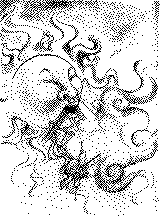SEPICA is the main instrument on ACE responsible for the determination of the ionic charge states of solar and interplanetary energetic particles. The charge state of energetic ions is key data, needed to determine source temperatures, acceleration, fractionation, and transport processes for these particle populations. Ionic charge results from SEPICA's predecessor the ISEE ULEZEQ instrument have shown, for example:
- The charge states of heavy elements in long duration solar flares -- indicating source temperatures of several million degrees -- differs from element to element. The physical processes behind this finding have not been completely resolved thus far.
- The charge states of Fe and Si from compact 3He-rich flares turned out to be significantly higher than those from long duration flares. No study of individual compact flares had been possible and the responsible physical processes are not yet clear.
- A substantial enhancement of He+ in interplanetary particles has been found. It has been suspected that this could be due to acceleration of interstellar pickup ions. No comprehensive study has been possible as yet.
To better understand the processes above, SEPICA was designed to provide superior charge state resolution and a larger geometric factor than ULEZEQ (see tables below). With these improved capabilities, individual charge states can now be resolved and counting statistics are more reliable.
Energy Range and Element Resolution
|
Energy Range
|
Resolution
|
Elements
|
| 0.3 - 6 MeV/N (He) |
isotopic |
He |
| 0.2-18 MeV/N (O) |
individual elements |
up to O |
| 0.1-5.4 MeV/N (Fe) |
groups,  Z/Z Z/Z  2-3 2-3 |
up to Fe |
Geometric Factor and Charge Resolution  Q/Q
Q/Q
|
Geometric Factor
|
 1 MeV/Q 1 MeV/Q
|
 3 MeV/Q 3 MeV/Q
|
| 0.2 cm2sr |
0.3 |
1 |
| 0.03 cm2sr |
0.1 |
0.3 |
To accurately measure the charge states of incoming ions SEPICA uses one high charge resolution sensor section and two low charge resolution sections. The charge resolution is achieved by focusing of the incoming ions through a multi-slit mechanical collimator, deflection in an elctrostatic analyzer with a voltage up to 30 kV, and measurement of the impact position in the detector system.
 Schematic view of the SEPICA instrument
Schematic view of the SEPICA instrument
To determine the nuclear charge and energy of the incoming ions, thin-window flow-through proportional counters with isobutane as the counter gas, and ion-implanted solid state detectors are used. The counters provide for three independant  E (energy loss) verses E (residual energy) telescopes. The multi-wire proportional counter simultaneously determines the energy loss (
E (energy loss) verses E (residual energy) telescopes. The multi-wire proportional counter simultaneously determines the energy loss ( E) and the impact position of the ions. Supression of background noise from penetrating cosmic radiation is provided by an anti-coincidence system with a CsI scintillator and Si photodiodes. The data are compressed and formatted in the S3DPU, which is shared with SWICS and SWIMS.
E) and the impact position of the ions. Supression of background noise from penetrating cosmic radiation is provided by an anti-coincidence system with a CsI scintillator and Si photodiodes. The data are compressed and formatted in the S3DPU, which is shared with SWICS and SWIMS.
Visit the Photo Gallery to see annotated photographs of SEPICA and ACE.

 Schematic view of the SEPICA instrument
Schematic view of the SEPICA instrument